33 Keys to Decoding the Korean Wave
#27 K-Adoptees Sparkle in Culture
*한류를 이해하는 33가지 코드 #27 입양한인 예술가들 <Korean version>
https://www.nyculturebeat.com/index.php?mid=Focus&document_srl=4087666

As of April 2021, Korea’s gross domestic product (GDP) stood at $1.8 trillion, ranking 10th in the world. The trade volume in 2020 amounted to $980 billion, securing the 7th position globally. Beyond its economic prowess, Korea has evolved into the world’s foremost cultural powerhouse. In the 21st century, the dynamic force of the Korean Wave, encompassing K-pop, K-cinema, K-drama, K-food, K-beauty, and more, continues to permeate across borders.
Yet, it’s crucial to acknowledge Korea’s historical struggles with war and poverty. The Korean War of 1950 left approximately 7.2 million refugees, with around 450,000 Korean soldiers and civilians losing their lives and 60,000 becoming war orphans. The aftermath left the country in ruins, leading to a significant number of orphans being adopted overseas. Regrettably, Korea earned the unfortunate title of the primary “orphan-exporting country,” with an estimated 200,000 Koreans adopted overseas since 1953, three-quarters of them by American families.
Adopted Koreans embarked on journeys with new families worldwide, assumed new names, and grew up in unfamiliar environments. Their adolescence often became a tumultuous period marked by identity confusion, resentment at being abandoned by their biological families, and sorrow over the unknown origins of their birth parents. As adults, some returned to Korea in search of their roots, while others exhibited their Korean DNA through various talents, including poetry, novels, art, classical music, opera, ballet, movies, comics, and cooking. “Blood is thicker than water.”
Here, I would like to introduce several noteworthy adopted Korean artists contributing to today’s K-Wave. Opera singer Andrew Gangestad, ballerina Jennifer Whalen, artist Sarah Sejin Chang, filmmaker Deann Borshay Liem, chef Danny Bowien, and violist Richard Yongjae O’Neill are among them. With the exception of O’Neill, I had opportunities to interview or meet them during my tenure as a reporter for The Korea Daily of New York, and while managing NYCultureBeat.com.
# Bass Andrew Gangestad (Jeong Woo-geun)
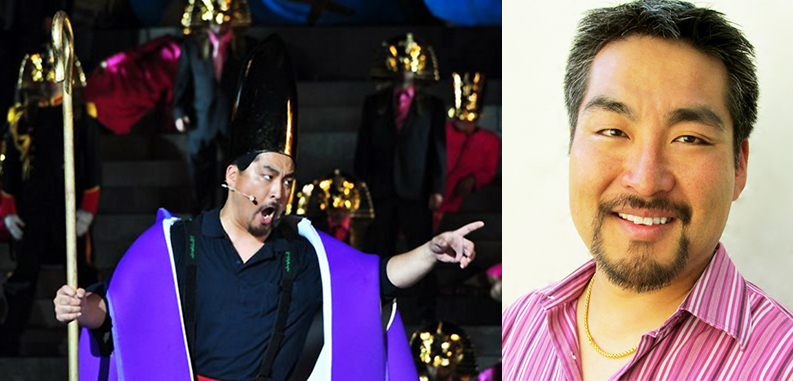
Bass Andrew Gangestad in "Aida" from the Bregenz Festival 2009 in Bregenz, Austria.
“Chillingly effective Ramfis” “the evening’s best all-around performance” “honeyed resonance, as the Count, all but stole the show” “notes with rich, unfettered sound” “marvelous voice, full and vibrant but capable of movement” “unusually distinctive, majestic-voiced Timur” “his luxurious, grandiose voice bursting with emotion” “a glorious bass voice” “a bass voice of great power and beauty”...
These are the accolades bestowed upon the bass Andrew Gangestad by the media. Gangestad has graced the stages of renowned institutions such as the Metropolitan Opera, New York City Opera, Minnesota Opera, Connecticut Opera, Kentucky Opera, Cincinnati Opera, Michigan Opera, Spoleto Festival, Welsh National Opera, and Bregenz Festival in Austria.
Born Jeong Woo-geun, in 1975, at the age of two, he resided at Hope Orphanage in Cheongwon, North Chungcheong Province, and was subsequently adopted by Sandy and Eugene Gangestad, a couple who operate a lumber company in Minnesota. At the time of adoption, the boy was grappling with tuberculosis and faced initial rejection. However, his adoptive parents funded his treatment, leading to a complete recovery a year later, after which he relocated to Two Harbors, Minnesota. Under the adopted name Andrew Gangestad, he grew up alongside his four sisters.
As a boy endowed with vocal prowess, Andrew participated in the choir and showcased his talent in musicals. While initially planning to major in law at Minnesota State University (Duluth), he crossed paths with an exceptional vocal professor, prompting a shift in his career trajectory towards vocal music.
Post-college graduation, Gangestad achieved recognition by reaching the finals of the Metropolitan Opera National Council Audition in 2000 and securing victory in the Fritz & Ravina Jensen Foundation Vocal Competition in 2005. He made his debut in 1999 as Lodovico in Verdi’s “Otello” at the Metropolitan Opera House in New York. Subsequently, he garnered acclaim for performances in both tragic and comedic productions like “Lulu,” “Don Carlo,” “Turandot,” “La Bohème,” “Don Giovanni,” “The Marriage of Figaro,” “The Barber of Seville,” and “Macbeth.”
In January 2007, soprano Hei-kyung Hong and tenor Wookyung Kim were the first Asian vocalists to perform together in the same performance as the male and female leads in “La Traviata” in the 127-year recorded history of the Met Opera. In June of that same year, Gangestad visited Korea for the first time since he left as a two-year-old infant, bringing with him an old black-and-white photo taken around the time he was adopted. Gangestad sought to connect with his Korean identity, asking profound questions about his past. He found his name in Korea, Jeong Woo-geun, and shared opera arias with the students at Hope Orphanage, where he spent his formative years. As part of his visit, Gangestad also performed “Bimok/ Tree of Sorrow” and “Boat Song” at the US Embassy.
In the summer of the same year, Gangestad collaborated with soprano Hei-kyung Hong as Mimi in “La Bohème” for the Met Opera in the Park series. He portrayed the role of the philosopher Colin and delivered a poignant rendition of “Vecchia zimarra, senti” (Listen, my old coat). Currently residing and working in Kansas City, Missouri, Gangestad continues to contribute his exceptional talents to the world of opera. http://andrewgangestad.com
#Ballet Dancer Jennifer Whalen (Nam Ji-yeon)
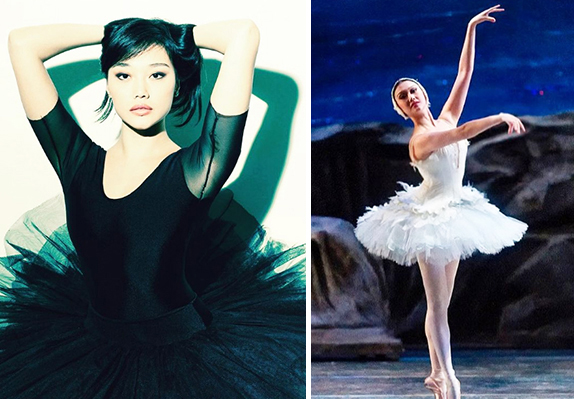
Jennifer Whalen in ABT's "Swan Lake"
Koreans are also dazzling at the American Ballet Theater (ABT), which performs regularly at the Metropolitan Opera House in Lincoln Center. In 2012, Hee Seo became the first Asian principal dancer at ABT, and in 2020, Joo Won Ahn was promoted to principal dancer. Among the 16 principal dancers at ABT, two Asian dancers are Korean. Kimin Kim, the first Asian principal dancer at the Russian Mariinsky Ballet, also has appeared on stage as a guest artist at ABT. Hee Seo and Kimin Kim performed as Nikia and Solar in “La Bayadere” in 2015, becoming the first Asian male and female leading roles to perform together in ABT’s history.
Before Hee Seo joined in 2005, Jennifer Whalen (Korean name Nam Ji-yeon), a Korean adoptee, was dancing in ABT’s Corps de Ballet. Nam Ji-yeon was adopted as an only child by an American couple, Barbara and Jeffrey Whalen, in Ventura, California, three months after she was born in Seoul in 1985. Jennifer first saw a ballet performance at the age of seven and she soon went on to train at the San Francisco Ballet, the Kirov Academy and the Royal Ballet School in London. Jennifer Whalen won a gold medal at the Youth American Grand Prix and first place at the LA Performing Arts Spotlight. In 2002, at the age of 17, she joined the ABT as an apprentice, and the following year she became a member of the Corps de Ballet. In an interview with me, she said that after Hee Seo joined, she started enjoying Korean food more, including dolsot bibimbap, ribs, and kimchi.
In 2008, Whalen searched for her biological mother following her performance in ABT’s “Don Quixote” while on tour in Korea. At the time, Whalen carried with her the Eastern Social Welfare Society adoption documents that she had kept dear. Holding documents stating, “adoption number 85C-283, birthplace Seoul, South Korea, birth time January 18, 1985 9:44 AM, her biological mother’s name Nam Seong-cheol, 18 years old, single, youngest of three sisters,” she set out to find her birth mother. However, she did not meet her birth mother then.
Four years later, Whalen met her biological mother in Korea for the first time in 26 years. Reunited on ABT’s Korean tour, mother and daughter exchanged flowers and gifts, ate Korean food, and chatted through an interpreter.
According to the New York Daily News, which reported the reunion at the time, Whalen said she was frustrated at being only able to communicate with her biological mother through an interpreter, and she was most curious about how much she resembled her mom.
The mother and daughter compared their height, hand, and foot sizes, and they were surprisingly similar. Both were suffering from scoliosis, a curvature of the spine that is a problem, especially for Whalen as a ballerina. Her mother had mentioned feeling terrible for giving her up, but she was so happy Jennifer had grown up beautifully and expressed joy in seeing her daughter dance. Unfortunately, Whalen’s biological father had passed away.
Jennifer Whalen, who aspired to become a teacher in her 30s, concluded her 15-year tenure with ABT in 2017. She now imparts her knowledge by teaching ballet at the Greenwich Ballet Academy in Connecticut and Broadway Dance Theater in New York City.
# Violist Richard Yongjae O'Neill

Richard Yongjae O'Neill and Ensemble DITTO
Violist Richard Yongjae O’Neill secured a win at the 63rd Grammy Awards in 2021. He clinched the Best Classical Instrumental Solo award for his album “Theofanidis: Concerto for Viola and Chamber Orchestra.” After being previously nominated in 2006 and 2010, O’Neill triumphed on his third nomination. Remarkably, he is the first violist in the history of Juilliard Music School to receive the Artist Diploma, the third violist to join the Chamber Music Society of Lincoln Center and the youngest faculty member at UCLA’s School of Music.
Born in Sequim, Washington, in 1978, Richard’s mother, Colin O’Neill (Korean name Lee Bok-soon), was an orphan from the Korean War and was adopted by a family in the United States in 1957. His mother, who suffered permanent brain damage due to malnutrition during her childhood, gave birth to Richard as a single mother, leaving him in the care of his white grandparents, Perry and Mildred O’Neill, who had adopted his mother.
In a 2013 interview with KoreAm, Richard shared his childhood challenges of growing up without knowing or ever meeting his white father. His father, a member of Washington’s Boeing family, was said to be an intelligent boy, but to have suffered from mental disorders until his death in 2004 in a motorcycle accident at the age of 15. Growing up in a majority-white town in Washington state, Richard was constantly bullied for having Asian features and his mother having a disability.
O’Neill transitioned to the viola at the age of 15, finding a connection to the instrument’s foreign feel compared to the violin and cello, and its comfort reminiscent of his mother’s voice. He pursued his musical education at the University of Southern California (USC) School of Music and received a full scholarship to the Juilliard School. Notably, he became the first violist to complete the Artist Diploma at Juilliard (an advanced post-graduate program). His Korean name, Yongjae (勇才), was bestowed by Professor Kang Hyo at Julliard, helping him embrace his Korean identity.
Richard Yongjae O’Neill performed with the Sejong Soloists led by Professor Hyo Kang and then with London Philharmonic, the Los Angeles Philharmonic, the Seoul Philharmonic and Moscow Chamber Orchestra, to name a few. O'Neill gained recognition and received Lincoln Center’s Avery Fisher Career Grant in 2006.
In 2004, O’Neill appeared in the KBS documentary "Human Theater," describing his search for his mother’s Korean family. As his life came into focus, O’Neill rose to stardom. In 2007, he initiated a chamber music project with young Korean musicians, forming the Chamber Ensemble DITTO. The ensemble, whose members other than O’Neill changed over the years, toured for 12 years, captivating audiences throughout Korea, and in Tokyo, Osaka, and Shanghai, establishing an "idol ensemble classical world."
O'Neill’s impact in Korea extended beyond music. He served as a coffee advertising model, a public relations ambassador for the Korean Red Cross, the UN World Day of Peace, and the Special Olympics Committee of Korea. Additionally, he appeared in the MBC drama “Beethoven Virus” on the variety show “The Knee-Drop Guru” and authored a book titled “Richard Yongjae O’Neill’s Empathy DITTO,” “Me and Your Beethoven.”
Navigating between the worlds of violin and cello, and spanning Korea and the United States, violist Richard Yongjae O’Neill affirmed his identity as “Yongjae” in Korea. He explored the stone wall walkways of Deoksugung Palace and Myeong-dong, developing a fondness for the taste of bulgogi and japchae. O’Neill concluded his journey with Ditto in Korea in 2019, returning to the United States to join the chamber ensemble Takács Quartet. He possesses a rare million-dollar viola crafted by Giovanni Tononi of Bologna around 1699.
# Artist Sara van der Heide (Chang Sejin)
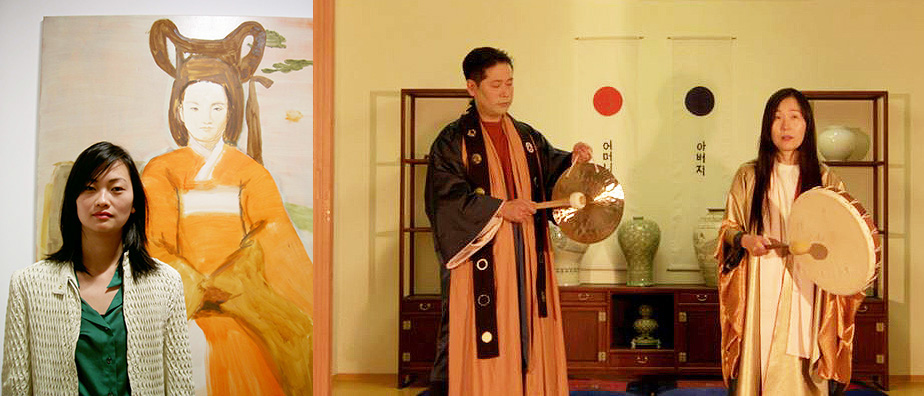
사라 반 더 하이데, 2007 Photo: Sukie Park/ Sara Sejin Chang, “Four Months, Four Million Light Years,” 2020. Photo: Silke Briel
When I met her around 2007, her name was Sara van der Heide, and she was an artist in residence in New York. She now goes by the name Sara Sejin Chang. She was a painter back then, but she now focuses on her performance and film work. Although she was completely private about her adoption memories at the time, she is now a harsh critic of the adoption industry and colonial history.
Chang Sejin was born in Busan in 1977 and was adopted by a family in the Netherlands. The Netherlands is the country of Vermeer, Rembrandt, and Van Gogh, and also the country where Hendrick Hamel, known for “Hamel’s Journal,” developed ties with Korea after a 13-year stay (1653-1666) in Joseon following a shipwreck.
Sara Sejin Chang studied at the State University of New York (SUNY, Purchase) as an exchange student in 1997. She majored in Art & Drawing History Education at the Amsterdam Academy of Fine Arts and later pursued painting at the Academy of Fine Art & Design (AKI) in the Netherlands. From 2006-17, she was an artist-in-residence at the International Studio & Curatorial Program (headquartered in New York), and taught at art schools in Utrecht and Amsterdam, the Netherlands, and Groningen, Germany.
As an artist, she has participated in the 2009 International Women Artist’s Biennale in Incheon, the 2012 Stedelijk Museum Amsterdam, the 2020 Berlin Biennale for Contemporary Art, and the 2022 Busan Biennale, and has had recent solo exhibitions in 2023 in Stockholm, Utrecht and Amsterdam. She currently is based in Berlin.
At the 11th Berlin Biennale of Contemporary Art, her piece “Four Months, Four Million Light Years” (2020) delved into her identity, international politics, and colonial history. Chang shed light on political and social issues through her personal story of being adopted in the Netherlands after abandonment in a Busan orphanage. She highlights cases of disappearances of adopted children, document falsification, and child trafficking in the 1970s when international adoption from Korea peaked. She unveils the violent eradication of shamanistic culture by missionaries and the criminality of modern cross-border adoption.
Growing up as an adoptee of color in the Netherlands, she learned that the Dutch “golden age” in the 17th century was also its most violent era, leading to a Eurocentric sense of superiority over Asians. This fostered feelings of pain, loss, and trauma related to her identity as an adopted Korean, a female artist, and an Asian, serving as an indictment of Europe’s colonial history. Through her art, she sublimates these experiences, akin to a shaman performing a rite. Her work may also serve as a healing process as she finds her own voice. Sara Sejin Chang dedicates the work to all global adoptive families. https://www.sarasejinchang.com
# Filmmaker Deann Borshay Liem (Kang Ok-jin)
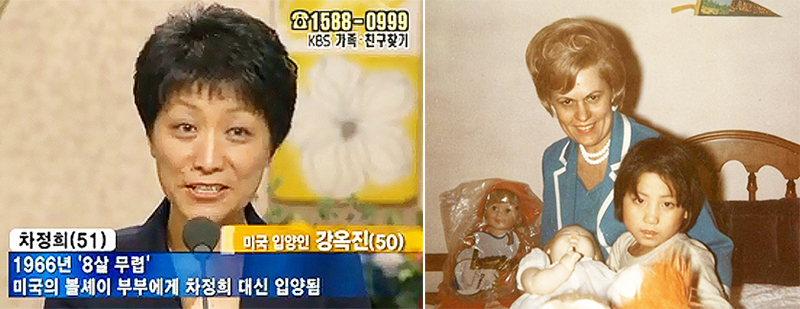
In The Matter of Cha Jung Hee, 2010/ Deann Borshay Liem with her adoptive mother
“In The Matter of Cha Jung Hee,” 2010/ Deann Borshay Liem with her adoptive mother
Director, producer, and writer Deann Borshay Liem made her filmmaking debut with “First Person Plural” (2000), a feature-length documentary about the mystery of her own adoption. Deann was adopted by a family in San Francisco, using Cha Jeong-hee’s passport when she was 8 years old in 1966. As an adult, while researching her adoption records, she discovered that her real name was Kang Ok-jin. She had been adopted by forging her documents from the orphanage, adding an extra layer of identity confusion by living in the United States under someone else’s name.
Her adoptive father documented Deann’s transformation into an ‘American girl’ from the time she arrived at the airport. Deann Borshay Liem, a psychology graduate from the University of California, Berkeley, took up the camera herself. Accompanied by her adoptive parents, she went to Korea to unravel the mystery of her identity. Liem was finally reunited with her biological family in Gunsan. The documentary is a poignant exploration of uncommunicative wailing and tears of repentance. “First Person Plural” was invited to the Sundance Film Festival, won the Grand Jury Prize in the documentary category at the San Francisco International Film Festival, and received a nomination for the Emmy Award for Best Director.
Ten years later, director Deann Borshay Liem embarked on her second film. Returning to Korea, she aimed to find the real Cha Jung Hee and uncover the mystery of the birthdate and name, Cha Jung Hee, that has been assigned to Deann on her legal papers, including her driver’s license. In the documentary “In the Matter of Cha Jung Hee” (2010), the process of searching Cha Jung Hee unveils the secrets and lies that shook her identity, addressing the social issues surrounding her adoption. In that sense, the camera could have been Deann Borshay Liem’s own therapy and healing. This film won the Special Jury Award, Best Director, and Best Editing at the LA Asian Pacific Film Festival.
In 2013, Deann Borshay Liem co-directed “Memory of Forgotten War,” narrating the story of division and separated families, alongside Boston University psychology professor Ramsay Liem. Liem is a Sundance Institute Fellow and the recipient of the Rockefeller Film/Video Fellowship. She is married to Korea Policy Institute’s Chairman Paul Liem. https://www.mufilms.org
# Chef Danny Bowien (Choi Won-sung)
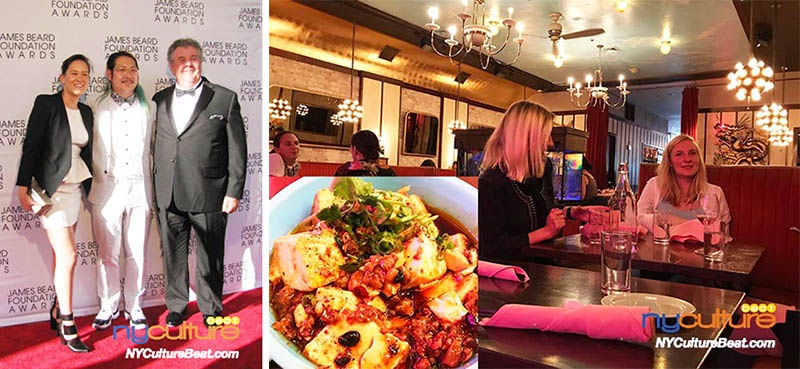
Danny Bowien with his wife and father at the James Beard Foundation Awards in 2013/ Mission Chinese Food in East Broadway and Mapotofu Photo: SUkie Park/NYCultureBeat
Alongside David Chang of Momofuku in NY, Roy Choi of Kogi in LA, Edward Lee of 610 Magnolia in Louisville, KY, and Corey Lee of Benu in San Francisco, Danny Bowien, who sparked the Korean chef craze in the United States, is an adopted Korean chef.
Choi Won-sung was born in Korea in 1982, and adopted by the Bowien family in Oklahoma City at three months old. Growing up, he watched TV cooking shows with his adoptive mother, and by the age of 13, he had a part-time job washing dishes at a Vietnamese restaurant. During high school, he played as a drummer in a rock band. When Bowien was 19, he went to San Francisco, a city with a large Asian population, and tasted Korean food for the first time in his life.
After training at a culinary school in San Francisco, he moved to New York, the “Mecca of the restaurant industry,” where he began his career in various restaurant kitchens. He later returned to San Francisco and worked in an Italian restaurant, winning the pesto competition in Genoa, Italy, in 2008.
Danny Bowien became a Sichuan cuisine genius in 2010 when he started a pop-up “Mission Chinese Food” in SF Chinatown with Anthony Mint. An adopted Korean who was neither Italian nor Chinese won a pesto competition in Italy and attempted to open a Chinese restaurant. This mirrors David Chang’s rise to stardom with Japanese ramen (Momofuku Noodle) and Chinese pork sandwich Pork Bun, rather than Korean cuisine. What David Chang and Danny Bowien have in common is their promotion of “delicious food” and “Americanized Asian food,” rather than cuisine strictly tied to nationality.
Bowien opened a NY branch of his “Mission Chinese Food” restaurant on Manhattan’s Lower East Side in 2013. Danny Bowien’s provocative recipes, including Kungpao corned beef, Chongqing chicken wings, and bacon and rice cake combos, fascinated New York Times critic Pete Wells and earned two stars. In the 2013 James Beard Foundation Awards, known as the “Oscars of the restaurant industry,” David Chang won the Outstanding Chef (joint winner), and Danny Bowien won the Rising Star Chef. Both chefs deserve high praise not only for showcasing Korean talent but also for popularizing Japanese ramen and Chinese Sichuan cuisine in America. Perhaps this success is rooted in the spirit of bibimbap, which embraces flexibility rather than rigid adherence to traditional recipes, reflecting the dynamic tastes of the Korean people.
During the COVID-19 pandemic, the Lower East Side branch closed in 2020, and the Bushwick branch in Brooklyn closed in 2022. However, the San Francisco headquarters remains open. Danny Bowien has a son with Korean adoptee Youngmi Mayer. https://www.missionchinesefood.com
*Beyond BBQ and Kimchi: Five Korean-American Star Chefs at Inside Korea’s Table
Kristen Kish, from Chef to TV Show Host

Adopted Korean chef Kristen Kish was selected as the host for the 21st season of cable TV Bravo channel’s cooking competition program “Top Chef” in July 2023.
Kristen Kish’s birth name, born in Seoul in 1983, is Kwon Young-ran. She grew up in an orphanage from the time she was a newborn, and when she was four months old, she was adopted by an American family and raised in Kentwood, Michigan.
Kish worked as a model in high school, and she studied at the culinary school Le Cordon Bleu in Chicago. Since 2012, she has been an instructor at celebrity chef Barbara Lynch’s cooking demonstration kitchen “Stir” in Boston, where she moved on to become Chef de Cuisine, and she also served as Chef de Cuisine at Lynch’s “Menton.” In 2018, she became the chef/owner of “Arlo Grey” in Austin, Texas.
Kristen Kish, who became known by appearing on “Top Chef” in 2012, co-hosted with Kyle Martino on the Travel Channel’s “36 Hours,” an adaptation of the New York Times series in 2015, and will be hosting Netflix’s “36 Hours” in 2022. She appeared in the “Iron Chef” series “Quest for an Iron Legend,” and went on to host the National Geographic series “Restaurants at the End of the World.”
NYT, "Adopted Chefs, Korean Cuisine, and Identity"
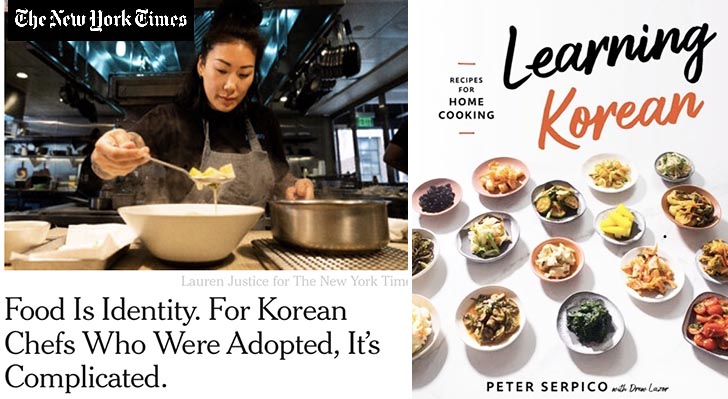
NYT, Adopted Chefs, Korean Cuisine, and Identity, July 31, 2022/ Peter Serpico's cookbook 'Learning Korean' (2022)
Korean American chefs such as Danny Bowien, David Chang, Corey Lee, Edward Lee, and Roy Choi may have influenced adopted Korean chefs in the United States. The New York Times published an article on July 31, 2022, titled “Food Is Identity. For Korean Chefs Who Were Adopted, It’s Complicated,” explaining the relationship between adoption and identity through food.
Katianna Hong, owner of “Yangban Society” in LA, Melanie Hye Jin Meyer, who operates “Tiny Chef - Korean Inspired Street Food,” a Korean pop-up restaurant in St. Louis, Tony Miller, chef of “Graze” in Madison, Wisconsin, Kate Telfeyan of “Porcelain” in Queens, New York, Peter Serpico, chef of a pop-up restaurant “Actually Good” in Philadelphia, chef Matt Blesse who moved to Korea, and Alyse Whitney, who runs the online recipe exchange website Adoptee Potluck Club, shared their stories in the Times.
The Times said, “For a Korean adoptee, eating Korean food can serve as a reminder of the loss, grief, and disconnection they’ve experienced. Cooking may intensify those feelings.” The reason why Korean adoptee chefs want to cook Korean food is, “For these chefs, cooking is the ultimate reclamation of their Korean-ness—and an act that propels the cuisine to exciting places.” The Times also reported that since 1953, about 200,000 Koreans have been adopted worldwide, with an estimated three-quarters of them adopted by American families.
Sukie Park
A native Korean, Sukie Park studied journalism and film & theater in Seoul. She worked as a reporter with several Korean pop, cinema, photography and video magazines, as a writer at Korean radio (KBS-2FM 영화음악실) and television (MBC-TV 출발 비디오 여행) stations, and as a copywriter at a video company(대우 비디오). Since she moved to New York City, Sukie covered culture and travel for The Korea Daily of New York(뉴욕중앙일보) as a journalist. In 2012 she founded www.NYCultureBeat.com, a Korean language website about cultural events, food, wine, shopping, sightseeing, travel and people. She is also the author of the book recently-published in Korea, "한류를 이해하는 33가지 코드: 방탄소년단(BTS), '기생충' 그리고 '오징어 게임'을 넘어서 (33 Keys to Decoding the Korean Wave: Beyond BTS, Parasite, and Squid Game)."

한류를 이해하는 33가지 코드
*Buy Here <US>
-KBOOKSTORE US $48.60
https://kbookstore.com/catalog/product/view/_ignore_category/1/id/694563/s/33-9788978895323
-반디북스 Bandi Books US $51.30
https://www.bandibookus.com/front/product/detailProduct.do?prodId=4461303
888-880-8622(Toll Free)
-고려서적 Koryo Books $90-$100
맨해튼 212-564-1844/ 뉴저지 201-461-0008
*Buy Here <Korea>
-알라딘 Aladin ₩40,500
https://www.aladin.co.kr/shop/wproduct.aspx?ItemId=318150433
[신간 안내] 한류를 이해하는 33가지 코드: 방탄소년단(BTS), 기생충과 오징어 게임을 넘어서
https://www.nyculturebeat.com/index.php?mid=Lounge2&document_srl=4097797
[NEW Book] '33Keys to Decoding the Korean Wave: Beyond BTS, Parasite and Squid Game'
https://www.nyculturebeat.com/index.php?mid=Zoom&document_srl=4097451
[언론 보도] 한류를 이해하는 33가지 코드
한국 중앙일보(중앙Sunday), 뉴욕 중앙일보, LA 중앙일보, 밴쿠버 중앙일보, 뉴욕일보, LA한국일보, 라디오 코리아...
https://www.nyculturebeat.com/index.php?mid=CulBooks&document_srl=4097741
[Media Coverage] '33Keys to Decoding the Korean Wave: Beyond BTS, Parasite and Squid Game'
https://www.nyculturebeat.com/index.php?document_srl=4097755&mid=Lounge2
[서점 통신] 한류를 이해하는 33가지 코드: 출간 이후
교보문고(반포 지점) 비치/ 알라딘 주간 베스트 인문-문화이론 부문 40위(6/13)/ 알라딘 첫 리뷰
https://www.nyculturebeat.com/index.php?mid=Lounge2&document_srl=4098111
*[들어가는 글] 뉴욕에서 한류를 목격하며...
https://www.nyculturebeat.com/index.php?mid=Focus&document_srl=4099765
*'한류를 이해하는 33가지 코드: BTS, 기생충, 그리고 오징어 게임을 넘어서'에 무엇이?
https://youtu.be/29auuZ2a_Ig






이들을(비올리스트 오닐을 빼고)인터뷰하고 기사를 쓴 컬빗에 감사를 드립니다.
-Elaine-